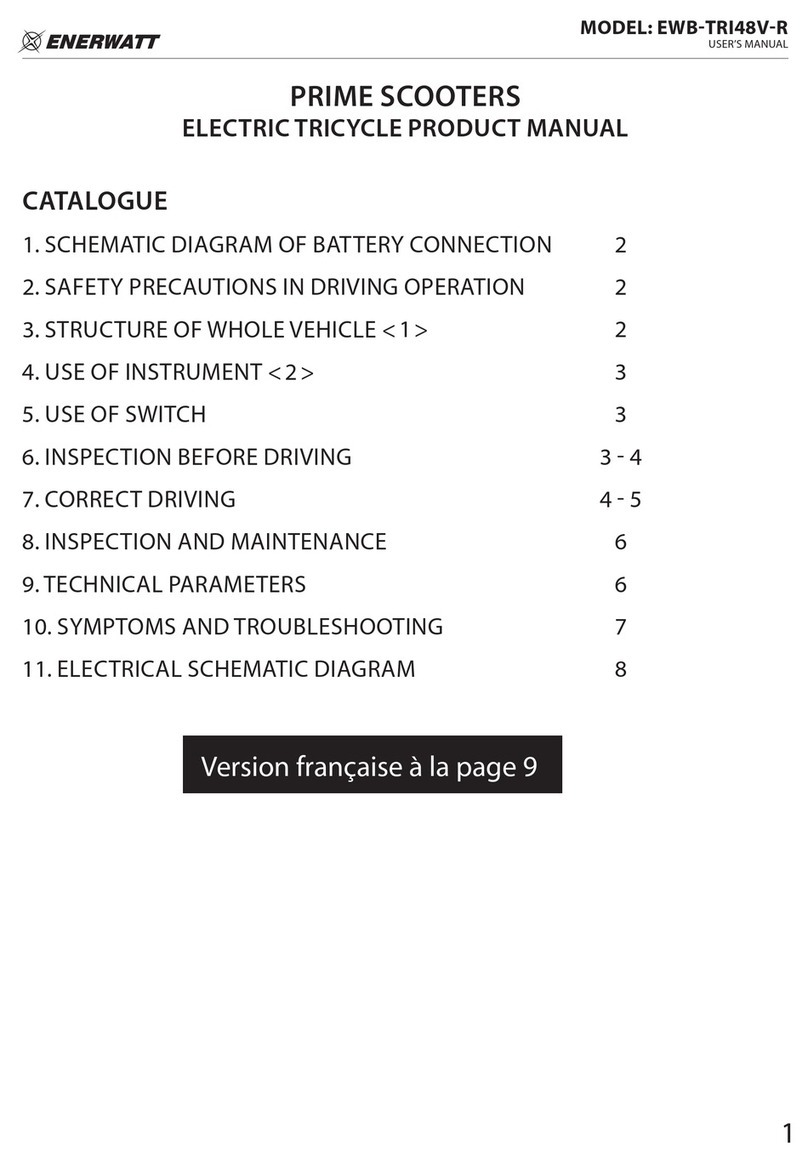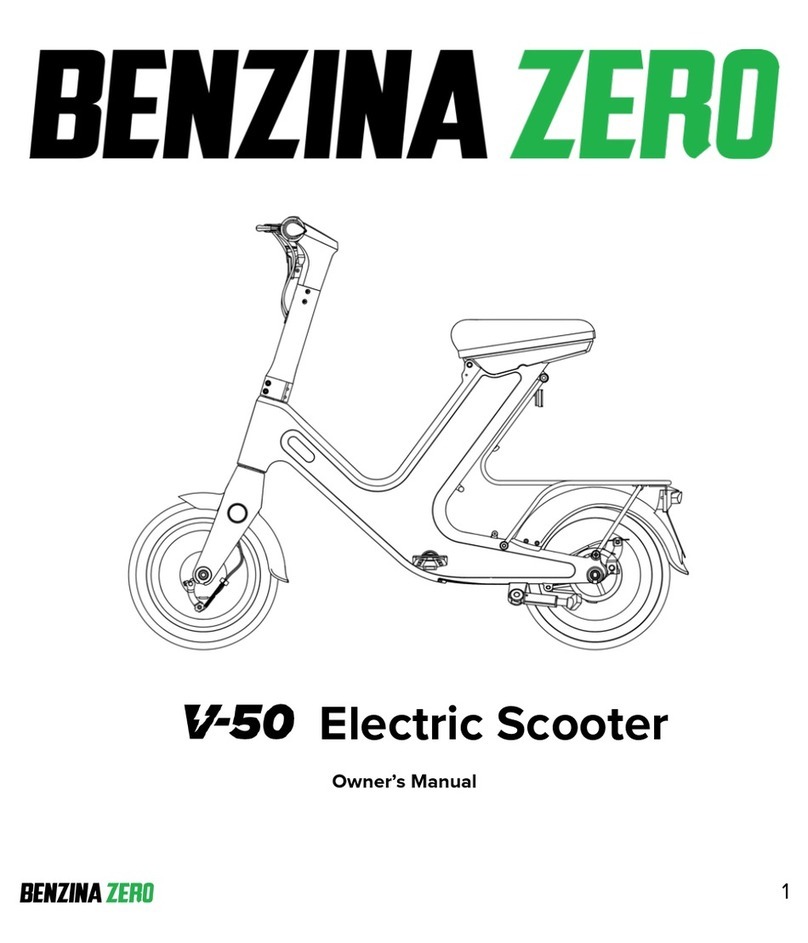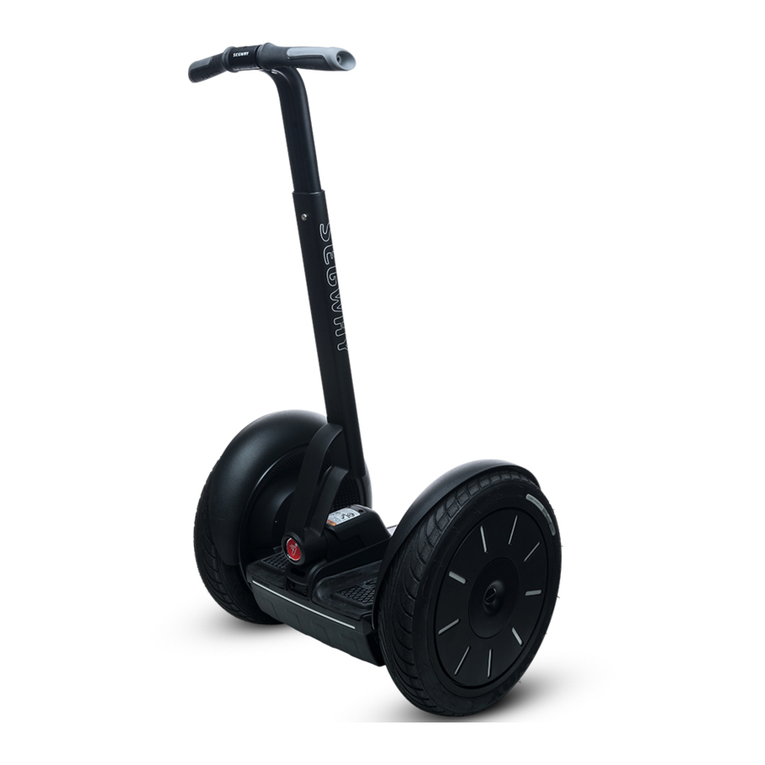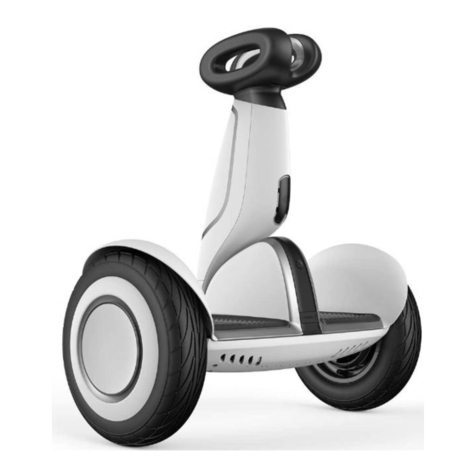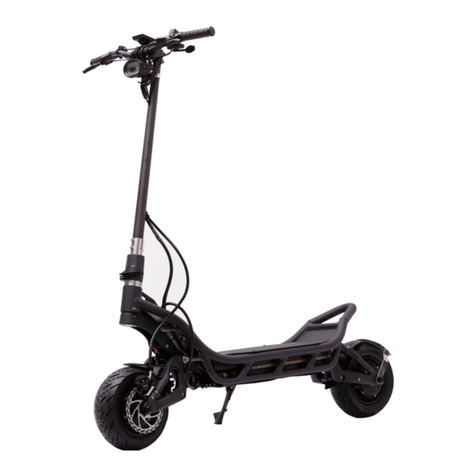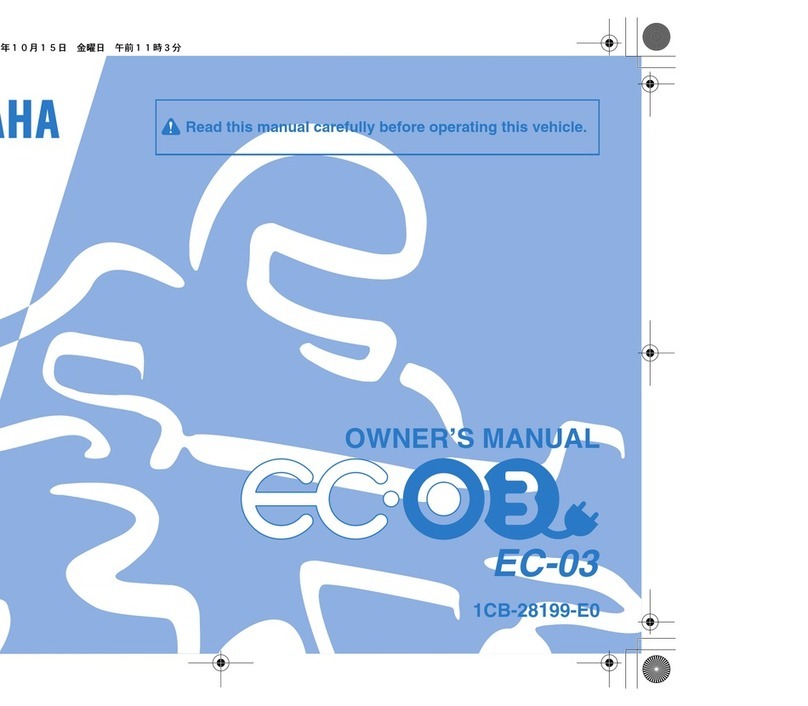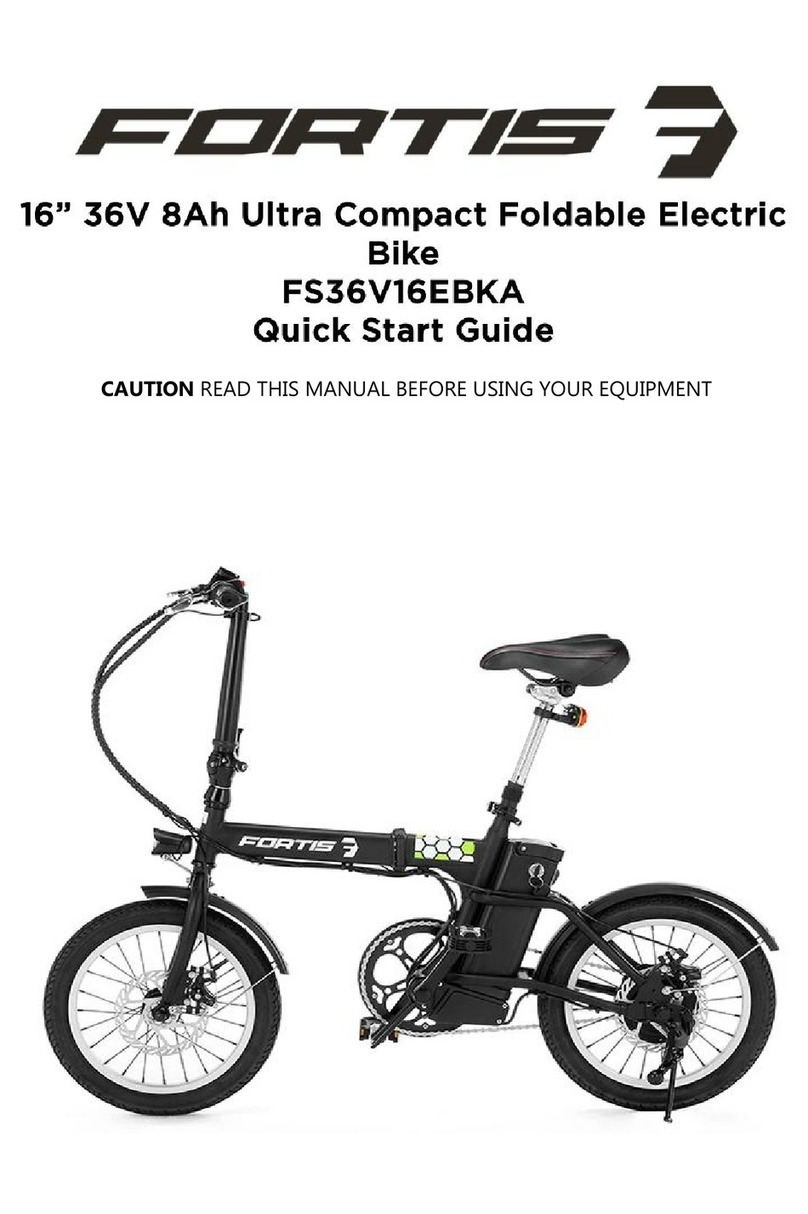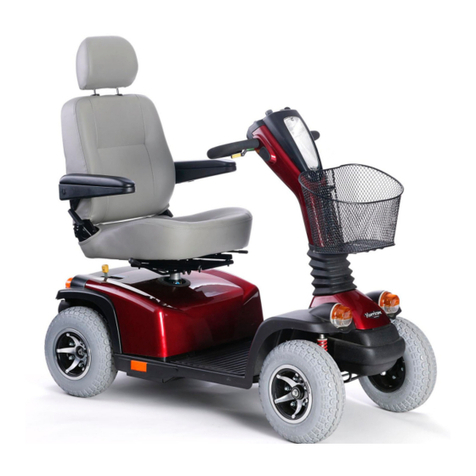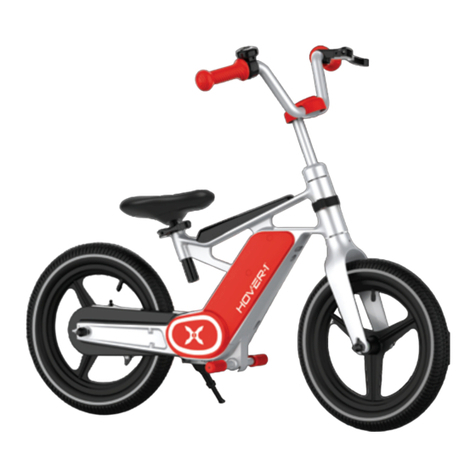Enerwatt EWB-QUAD24V-R User manual

1
MODEL: EWB-QUAD24V-R
USER’S MANUAL
OWNER'S MANUAL FOR YOUR SCOOTER
1. INTRODUCTION 2
2. SPECIFICATIONS AND STRUCTURE 3 4
3. INITIAL ASSEMBLY 5
4. DISASSEMBLY 6
5. COMFORTABLE ADJUSTING 6 7
6. OPERATION 7 9
7. BATTERY AND CHARGING 9 11
8. CARE AND MAINTENANCE 12 13
9. SAFETY 14 16
10. ELECTROMAGNETIC INTERFERENCE 17
Version française à la page 18

2
MODEL: EWB-QUAD24V-R
USER’S MANUAL
1. INTRODUCTION
Thank you for purchasing this scooter. This scooter design combines the most advanced state-of-the-art components with modern,
attractive styling. We are certain that the best performance, safety and comfort, and trouble-free operation of your scooter will add
convenience to your daily life.
Many important safety, operating, and maintenance instructions are included in this Owner's Manual. We urge you to read the entire
manual carefully before attempting to operate your scooter for the rst time. These instructions were compiled for your benet. It is
essential to understand these instructions for the safe operation of your new scooter.
Our company is not liable for damage to property or personal injury arising out of the failure of any person and/or user to follow the
instructions and recommendations set forth in this manual or any other requirements.
If you experience any problems with your scooter that you are not able to solve, or if you do not feel capable of safely following any
of the instructions and /or recommendations contained in this manual, please contact our authorized provider.
Once you understand how to operate and take care of your scooter, we are sure that it will give you years of trouble-free service and enjoyment.
The icons below, which appear throughout the manual, are used to remind you to pay attention. All of them relate to your safety.
It is strongly recommended to read them carefully and understand them completely.
WARNING!
This icon indicates that serious personal injury could occur if the information
in this manual is ignored.
CAUTION!
This icon indicates that the scooter may break down if the information
in this manual is ignored.

3
MODEL: EWB-QUAD24V-R
USER’S MANUAL
2. SPECIFICATIONS AND STRUCTURE
Your scooter comprises four sections: a front section, a rear section, a seat unit and a battery.
A tiller console, handle bar and a footplate are located on the front section.
A driving motor, a brake system and the control electronics are located on the rear section.
The seat unit comprises a seatback and armrests etc. (see g. 1).
FIGURE 1
Seatback Tiller console
Tiller
Lock-nut
Front section
Anti-tip wheels
Rear section
Armrest
Seat lock lever
Rear section

4
MODEL: EWB-QUAD24V-R
USER’S MANUAL
2. SPECIFICATIONS AND STRUCTURE CONTINUED
TILLER CONSOLE SEE FIG. 2
A. Key switch
B. Speed adjustment knob
C. Battery status indicator
D. Horn button
E. Headlight button
F. Throttle control lever
G. Tiller
CHARGING AND CONTROL SYSTEM SEE FIG. 3
A. 3-pin charger power receptacle
B. Load protector
SEAT UNIT
A. Seat base
B. Seatback
C. Armrests
D. Seat lock lever
A. Key switch
C. Battery status indicator
D. Horn button
B. Load protector A. 3-pin charger power
receptacle
F. Throttle control
lever
G. Tiller
B. Speed adjustment
knob
E. Headlight
button
FIGURE 3
FIGURE 2
SPECIFICATIONS
Drive wheel 200 mm solid wheel
Front wheel 200 mm solid wheel
Anti-tip wheel 56 mm solid wheel
Limit speed Forward speed 6 km/h, reverse speed 3.5 km/h
Braking system Intelligent brake
Distance between
ground and footplate 90 mm
Turning radius 1000 mm
Dimensions 1030 x 510 x 830 mm
Seat unit Standard light backrest with folding sponge seat
Drive system Single motor drive
Batteries 12V/12Ah x 2 pcs
Motor power 24 180 W
Travel range 17 km
Charger 24V/2A portable
Weight capacity Rated 75 kg, maximum 120 kg
Climbing slope Rated 8", maximum 12"
Charging time 10-12 hours
Component weight
Main frame: 27 kg
Seat unit: 10 kg
Batteries: 9 kg per unit

5
MODEL: EWB-QUAD24V-R
USER’S MANUAL
3. INITIAL ASSEMBLY
For ease of transportation and to reduce possible damage,
the batteries and the seat unit are packaged separately.
You need to assemble them on the main frame of your scooter.
OPENING THE PACKING BOX
Open the packing box of your new scooter and remove all protective liners,
and then remove the folded scooter from the box.
ADJUSTING ANGLE OF TILLER
• Loosen the lock-nuts (see g. 4).
• Lift the tiller up to the correct angle.
• Tighten the lock-nuts to x the tiller.
ASSEMBLE THE SEAT SUPPORT
• Insert the seat support into the seat tube located
on the rear section (see g. 5).
• Align the bolt hole.
• Insert the bolt into the hole.
ASSEMBLE BATTERY UNIT
Put battery into trough, align electrode terminal on battery
with that in the trough, (see g 6).
ASSEMBLE SEAT UNIT
• Put the seat onto the seat support (see g 7).
• Pull out the seat-lock lever, adjust seat to the required position.
The seat will be locked automatically.
• Insert 1 left and 1 right armrest into the square tube separately.
• Adjust to the desired position and tighten lock-nuts.
ASSEMBLE NET-BASKET
• Remove the 2 screws located on the front of tiller (see g.8).
• Assemble the net basket xture to the front of tiller.
• Insert the net-basket into the xture.
Note: The net-basket should be ordered separately.
LOOSEN THE LOCKED HANDLEBAR
• Turn the locked handlebar counter-clockwise to loosen it. (see g 9)
FIGURE 4
FIGURE 6 FIGURE 7 FIGURE 8 FIGURE 9
FIGURE 5
CAUTION!
Please always keep electrode dean before installing.
If it is not clean, the contact between the battery packs and the electrode terminal may not be eective.
The scooter will not start if the battery is connected incorrectly.

6
MODEL: EWB-QUAD24V-R
USER’S MANUAL
4. DISASSEMBLY
For convenient transportation and storage, your scooter is designed to be disassembled and assembled easily without any special
tools. You can easily disassemble the scooter into four pieces: the front section, the rear section, the seat unit and the batteries
(see g 10). You can also re-assemble these parts quickly.
DISASSEMBLY
• Shut o the power and pull the lock lever under the seat base
to unlock the seat.
• Lift the seat up and o the scooter (see g. 7).
• Lift the battery case up (see g. 6).
• Loosen the nuts on the plug of the front and rear power connectors,
then remove them (see g. 11).
• Pull the nylon rope onto the lock hook and move it forward
to remove it (see g. 12).
• Lift the front and rear sections through the middle, lift the lock hook
on the body (see g. 13).
• Loosen the knob on the end of tiller, then incline the tiller (see g. 4).
5. COMFORTABLE ADJUSTING
Before operating the scooter, you may nd the need to make some adjustments for your comfort,
such as seat height, armrest width and tiller angle etc.
SEAT HEIGHT ADJUSTMENT
To change seat height, select dierent holes.
• Pull back the seat lock lever under the right side of the seat to unlock the seat.
• Lift the seat up and o the scooter (see gure 7).
• Hitch the pin loop and pull out the pin (see gure 5).
• Slide the seat post up or down to change seat height as required.
• Re-insert the pin.
• Re-install the seat.
SEAT ROTATION
• You can rotate the seat to adjust its direction (see gure 14).
• Pull up the seat lock lever to unlock the seat.
• Rotate the seat to the desired position.
• Release the seat lock lever, it will relock the seat automatically.
FIGURE 11 FIGURE 12 FIGURE 13
FIGURE 14
FIGURE 10
Rear Section Seat unit
Front Section
Battery unit
WARNING!
Remove the key from the key switch before making any adjustments.
Never attempt to perform adjustments while the scooter is in motion.

7
MODEL: EWB-QUAD24V-R
USER’S MANUAL
5. COMFORTABLE ADJUSTING CONTINUED
ARM REST WIDTH ADJUSTMENT
You can move the armrests inward or outward to adjust the seat width (see gure 15).
• Locate the screw on the armrest adjustment rack.
• Loosen the screw.
• Move the armrests inward or outward to the desired position.
• Tighten the screw.
TILLER ANGLE ADJUSTMENT
You can adjust the position of the tiller from the footplate
to the furthest forward stop (see gure).
• Loosen the lock nuts on the underside of the tiller.
• Move the tiller forward or backward to a comfortable position.
• Tighten the lock nuts.
6. OPERATION
TILLER CONSOLE
The tiller console houses all the controls needed to drive your scooter, including the key switch, the speed adjustment knob, throttle
control lever, battery status indicator, horn button and headlight button. With all of controls on the console you can control all functions
of your scooter.
POWER SWITCH (SEE FIGURE 2)
• Insert the key into the power unit.
• The indicator on the gauge lights up.
• When you remove the key, the power indicator goes o.
FIGURE 15
WARNING!
Do not use the key switch to stop your scooter unless in case of an emergency.
If your scooter is stopped for a long time, turn o the power to prevent it from moving unintentionally.
THROTTLE CONTROL LEVER (SEE FIGURE 2)
This lever allows you to control the forward and reverse speed of your scooter up
to the maximum preset speed using the speed adjustment knob.
• Press the lever down using your thumb to disengage the brakes and start moving.
• The greater the rotating angle of the lever is, the faster the speed of your scooter.
• If you release the lever completely, it automatically returns to neutral position, i.e. stop position,
and engages the scooter brakes to slow the scooter until it comes to a complete standstill.

8
MODEL: EWB-QUAD24V-R
USER’S MANUAL
6. OPERATION CONTINUED
SPEED ADJUSTMENT KNOB
This knob allows you to preset and limit your scooter's top speed. Maximum forward speed: 6 km/h, maximum reverse speed: 3.5 km/h.
BATTERY STATUS INDICATOR
When your scooter is powered up, this indicator shows the remaining battery capacity by red, yellow and green indicators on the panel.
• If the indicator is green, the batteries are fully charged.
• If the indicator is yellow, this indicates that batteries are at half capacity, and need to be charged.
• If the indicator is red, this indicates that the batteries are almost depleted, and need to be charged immediately.
WARNING!
If your scooter moves unintentionally, please release the throttle control lever immediately.
The scooter will stop automatically unless this lever is out of order.
CAUTION!
Before you are completely familiar with the operating features, please set this speed adjustment
knob to the lowest position.
HORN BUTTON (See Figure 2)
This button activates a warning horn.
HEADLIGHT BUTTON (See Figure 2)
This button activates headlights.
OFF-BOARD CHARGER (See Figure 3)
Open the clip on the battery case and use the o-board charger to charge
your batteries using a 3-pin charger power supply in the centre of the scooter
(see VII Batteries and charging).
LOAD PROTECTOR (See Figure 3)
The load protector is a safety device.
When an overload occurs, the protection device automatically trips to protect the motor
and other electric devices. When the protector
trips, your scooter must be powered down immediately. Wait at least one minute
before pressing the button on the load protector located under the cover at the rear of the scooter to restart. After that you can
power up the scooter and drive normally.
MANUAL FREE WHEEL LEVER
There is a freewheel lever at the bottom right of the seat base, shown in Figure 16.
If you do not wish to move your scooter by motor power, it can be done in freewheel mode.
• Pull forward on the manual freewheel lever to disable the drive motor and change to freewheel mode.
• Push backward on the manual freewheel lever to re-engage the drive motor and take your scooter out of freewheel mode.
FIGURE 16
Freewheel lever
CAUTION!
• When your scooter is in freewheel mode, the brake system is disabled.
• Never use your scooter in freewheel mode without paying attention.
Failure to do so may cause personal injury.
• Never sit on your scooter when it is in freewheel mode. Failure to do so may cause personal injury.
• Never put your scooter in freewheel mode on any incline. Failure to do so may cause personal injury.

9
MODEL: EWB-QUAD24V-R
USER’S MANUAL
6. OPERATION CONTINUED
3-PIN CHARGER POWER RECEPTACLE
This device is used to connect to the charger. When the batteries are charging, this device shuts o your scooter.
LOCK LEVER (see Figure 9)
In order to ensure safety during transportation, there is a lock lever at the front of the scooter.
• Turn clockwise 90° to lock the lever, then the scooter can be moved.
• Turn counter-clockwise 90° to unlock the lever, then the scooter can be driven.
WARNING!
When your scooter is in powered mode, the manual freewheel lever must be in downward
position, i.e. in powered mode, so as to ensure that the brake system is operating normally.
Failure to do so may cause the brake system to fail and cause personal injury.
WARNING!
A wrong connection may cause damage to the charger, connectors and electronics.
7. BATTERY AND CHARGING
Your scooter uses two long-life, 12-volt, deep cycle batteries.
These batteries are sealed and maintenance free.
As they are sealed, there is no need to check the electrolyte (uid) level.
Deep-cycle batteries are designed to handle a longer and deeper discharge.
Though they are similar in appearance to automotive batteries, they are not interchangeable.
Automotive batteries are not designed to handle a long, deep discharge, and also are unsafe for use in the scooter.
CHARGING YOUR BATTERIES
The battery charger is essential to ensure the long life of your scooter batteries.
This charger charges your scooter's batteries safely, quickly and easily.
WARNING!
Battery posts, terminals, and related accessories contain lead and lead compounds.
Wash your hands after handling.
WARNING!
You must charge your scooter's battery with the supplied o-board battery charger.
Do not use an automotive-type battery charger.

10
MODEL: EWB-QUAD24V-R
USER’S MANUAL
7. BATTERY AND CHARGING
CHARGING YOUR BATTERIES WITH THE OFF-BOARD CHARGER
• Position your scooter close to a standard wall outlet.
• Open the clip on the battery case.
• Ensure the scooter is powered down.
• PIug the output connector of the o-board into the 3-pin charger power device.
• Plug the input connector of the o-board charger into the wall outlet.
• The red light on the charger turns on indicating it is charging.
• When charging is nearly nished, the green light turns on.
You should continue to charge the batteries for a short period of time.
• It is recommended that you charge your batteries for 10 to 12 hours.
• When the batteries are fully charged, unplug the o-board charger from the wall outlet and
then from the 3-pm charger power device.
• Put the charger with its cord into the rear bag of your scooter.
• The battery can also be charged o-scooter.
NEW BATTERY USAGE
To prepare new batteries for maximum eciency, please follow the recommendations below:
• Fully recharge a new battery prior to its initial use. This brings the battery up to about 90% of its peak performance level.
• Operate your scooter. Move slowly at rst, and do not go too far until become accustomed to your scooter and known
how to control the driving distance from the battery condition indicator.
• Give the batteries another full charge of 10 to 12 hours and operate your scooter again.
The batteries will now perform at over 90% of their capacity.
• After four or ve charging cycles, the batteries will reach 100% charge and last for an extended period.
FREQUENTLY ASKED QUESTIONS FAQS
HOW DOES THE CHARGER WORK?
The battery charger takes the standard wall outlet AC voltage (alternating current) and converts it to 12V DC (direct current).
This scooter's batteries use direct current to run your scooter. When the battery voltage is low, the charger sends more current to the
batteries so that the charger becomes warm, which is normal.When the batteries are fully charged, the current sent from the charger
is almost zero. Therefore, when the charger is plugged in, it does not overcharge the batteries. When your scooter's charger will not
operate after the batteries have been discharged to almost empty, call our authorized provider for assistance.
CAN A DIFFERENT BATTERY CHARGER BE USED?
You should use the o-board charger supplied with your scooter, as it is the safest, most ecient tool to charge the batteries.
We do not recommend using other types of chargers (e.g. an automotive battery charger).
HOW OFTEN MUST THE BATTERIES BE CHARGED?
You can charge the batteries as soon as you are nished using your scooter, which prolongs the life of batteries.
INFREQUENT USE
If you use your scooter infrequently (once a week or less), you should charge the batteries for 10 to 12 hours at least once per week.
WARNING!
The battery should be stored on a clean, dry, at and non-conductive surface,
otherwise the battery may be a re hazard.
NOTE
Keep batteries dry and avoid discharging your batteries totally.
Do not charge the batteries for more than 24 hours per charging cycle.

11
MODEL: EWB-QUAD24V-R
USER’S MANUAL
7. BATTERY AND CHARGING CONTINUED
HOW CAN I GET MAXIMUM RANGE PER CHARGE?
It is rare to ideal driving conditions such as smooth, at, hard terrain with no hills or curves. It is more frequent to encounter hills,
potholes, uneven and loose surfaces, and curves. All of these factors will aect the running distance or running time per battery
charge. Below are a few suggestions for obtaining the maximum range per charge:
• Always charge the batteries fully prior to your trip.
• Plan your trip in advance to avoid inclines if possible.
• Limit baggage weight to essential items.
WHAT TYPE OF BATTERIES SHOULD I USE?
We recommend deep-cycle batteries that are sealed and maintenance-free.
Both SLA and Gel-Cell are deep-cycle batteries that have a similar performance.
Refer to the following specications to re-order deep-cycle batteries:
WHY DO MY NEW BATTERIES SEEM WEAK?
Deep-cyclebatteriesemployamuchdierentchemicaltechnologythanthatusedincarbatteries,nickelcadmium,orinothercommon
battery types. Deep-cycle batteries are specically designed to provide power, drain their charge, and then accept a relatively quick
recharge. AGM and Gel-Cell batteries should be charged as often as possible.They do not have a memory like nickel cadmium batteries.
We work closely with our battery manufacturer to provide a battery that best suits your scooter's specic demands. Fresh batteries
are promptly shipped with a full charge. During shipping, the batteries encounter temperature extremes that may inuence
initial performance. Heat drains the charge from the batteries, and cold slows the power available and extends the time needed
to recharge the batteries (as with car batteries). It might take a few days for the temperature of the battery to stabilize and adjust
to its new ambient temperature. More importantly, it will take a few recharging cycles (partial drain followed by a full recharge) to
establish the critical chemical balance that is essential to the battery's peak performance and long life. It is worth taking the time to
break in your battery properly.
CAUTION!
The service life of batteries frequently reects the care they receive.
Type Deep-cycle sealed lead acid
or gel cell
Size 152 x 99 x 9 (5 mm)
Voltage 12 volts each
Amperage 12 AH (amp hours)
HOW CAN I ENSURE MAXIMUM BATTERY LIFE?
A fully charged deep-cycle battery will provide reliable performance and extended battery life. Keep your scooter batteries fully
charged whenever possible. Batteries that are regularly and fully discharged, infrequently charged, or stored without a full charge
may be permanently damaged, causing unreliable operation and limited battery life.
HOW SHOULD I STORE MY SCOOTER AND ITS BATTERIES?
If you do not use your scooter regularly, we recommend maintaining battery lifetime by charging the batteries at least once per
week. If you do not plan on using your scooter for an extended period, fully charge the batteries prior to storage. Disconnect the
battery connectors and store the scooter in a warm, dry place. Avoid extreme temperatures, such as excessively cold and hot conditions,
and never attempt to charge a frozen battery. A cold or frozen battery should be warmed for several days prior to recharging.
WHAT ABOUT TRANSPORTATION?
AMG and Gel-Cell batteries are designed to be used in scooter and other mobility vehicles. These batteries are authorized for safe
transportation on aircraft, buses and trains, as there is no danger of spillage or leakage.We suggest you contact the carrier's company
in advance to determine that carrier's specic requirements.
WARNING!
Do not attempt to charge a cold or frozen battery.
You should warm them up for several days prior to charging.

12
MODEL: EWB-QUAD24V-R
USER’S MANUAL
8. CARE AND MAINTENANCE
For safe use and extended service life, your scooter (like any motorized vehicle) requires routine maintenance. Preventive
maintenance is very important. You can perform some of these regular checks yourself. If you follow the maintenance checks in this
section as scheduled, you can help ensure that your scooter gives you years of trouble-free operation.
MOISTURE
You should avoid storing your scooter in damp environments. Direct exposure to water or dampness could cause your scooter’s
electronic and mechanical parts to malfunction. Water can cause electrical components to corrode and the scooter's frame to rust.
Should your scooter come into contact with water:
• Dry your scooter as thoroughly as possible with a towel.
• Allow your scooter to rest in a warm, dry place to let invisible condensation evaporate.
• Perform safety checks of all operating functions before using your scooter.
• If you discover any inconsistencies, contact an authorized service centre.
TEMPERATURE
• Some of the parts of a scooter are susceptible to extreme changes in temperature.
Always keep your scooter in proper range of temperature.
• In extremely cold temperatures the batteries freeze.
The specic temperature at which they are frozen depends on several factors, such as battery charge,
usage, and composition of the batteries (e.g. AGM or Gel-Cell).
• Temperatures above 45oC may cause your scooter to operate at reduced speed.
This safety feature is preset to help prevent damage to the motor and other electrical components.
GENERAL GUIDELINES
• Avoid knocking or bumping the consoles.
• Avoid prolonged exposure of your scooter to extreme conditions, such as heat, cold or moisture.
• Keep the tiller console clean.
• Check all connectors to ensure that they are tight and secured properly.
• Check all electrical connectors including the charger's connectors. Make sure they are all tight and are not corroded.
Batteries must lie at in the battery case.
• The yellow light comes on to indicate that the batteries are half empty and need to be charged, but the scooter can still be used.
• The red comes on to indicate the batteries are almost empty and need to be charged immediately.
• The body is coated in a clear sealant. You can apply a light coat of a car wax to help retain its high-gloss appearance.
• All wheel bearings are pre-lubricated and sealed. They require no subsequent lubrication.
CAUTION!
If you do not use the scooter for a long period, we recommend you to engage the scooter's
kickstand to prevent the tires from coming into contact with the ground.
DAILY CHECK
• With the power turned o, check the throttle control lever. Make sure it returns to the primary position when you release it.
• Check the right/left lock-nuts on the bottom end of the tiller. Make sure they are fastened to the tiller.
WEEKLY CHECK
• Check all electrical connectors. Make sure they are not loosened or corroded.
• Check the body joint bolt. Make sure this bolt is tightened.
• Check the brakes. This test should be carried out on an even surface with at least one meter of clearance around your scooter.
MONTHLY CHECK
• Check the anti-tip wheel. Make sure it does not touch the ground.
• Check the anti-tip wheel. Make sure it is not seriously worn. If it is worn it should be replaced.
• Check the drive wheels for wear. If they do require repair, contact an authorized provider.
• Keep your scooter clean and free of foreign bodies, such as hair, food, drink, dust and mud etc.

13
MODEL: EWB-QUAD24V-R
USER’S MANUAL
8. CARE AND MAINTENANCE CONTINUED
YEARLY CHECK
• Take your scooter to an authorized provider for yearly maintenance.
This helps ensure that your scooter is functioning properly and prevents future errors.
STORAGE
Your scooter should be stored in a dry place, away from extreme temperatures.
Otherwise, the frame, the connections, and the electronics may rust and damage.
When storing your scooter, disconnect the batteries.
CLEANING
• Never clean your scooter with a hose or place it in direct contact with water.
• Your scooter has a painted, ABS plastic body coating and can be easily wiped clean with a damp cloth.
• Never use chemical cleaners on the seat, as they may cause the seat to become slippery or dry out and crack.
Clean with a damp cloth or neutral soapy water and dry the seat thoroughly.
PRE-RIDE SAFETY CHECK
We recommend you perform a safety check before each use to make sure your scooter is running smoothly and safely.
See 8 CARE AND MAINTENANCE.
Perform the following checks prior to using your scooter:
• Check all electrical connections. Make sure they are tight and not corroded.
• Check all connections to the battery box. Make sure they are secured properly.
• Check the brakes. See VIII CARE AND MAINTENANCE.
• Check the battery charge. See VII BATTERIES AND CHARGING.
WEIGHT RESTRICTIONS
Your scooter is rated for a weight capacity of 75 kg. The maximum weight limit is 120 kg.
WARNING!
Exceeding the weight limit voids your warranty and may result in personal injury
and damage to your scooter.
INCLINE INFORMATION
Many buildings have ramps with specic inclinations, designed for easy and safe access. Some ramps may have turning switchbacks
(180 degree turns) that require you to have good cornering skills on your scooter. When entering an incline, try to keep your scooter
moving. If you must stop to restart the scooter, you should accelerate with caution. When driving down an incline, set the speeder
to the slowest position and set the forward/backward button to forward mode. If your scooter starts to move down the incline faster
than you anticipated or desired, allow it to come to a complete stop by releasing the throttle control lever. Then rotate down the
speed adjustment knob and push the throttle control lever down slightly to ensure a safety-controlled descent.
WARNING!
• When entering an incline, do not zigzag or drive at an angle up the face of the incline.
Drive your scooter straight up the incline. This greatly reduces the possibility of a tip or a fall.
Always exercise extreme caution when negotiating an incline.
• Do not drive up or down a potentially hazardous incline
(i.e. areas covered in snow, ice, cut grass, or wet leaves).
• Never drive down an incline backward. This could result in personal injury.

14
MODEL: EWB-QUAD24V-R
USER’S MANUAL
9. SAFETY
BRAKING INFORMATION
Your scooter is equipped with two powerful brake systems:
• Electric brake system: This system can gradually slow and stop your scooter, if you release the throttle control lever
to let it return the top/stop position during driving.
• Motor brake system: After the electric brake system slows your scooter almost to a stop,
a damper in the motor brake system can automatically engage to ensure your scooter is at a complete standstill.
OUTDOOR DRIVING SURFACES
Your scooter is designed to provide optimum stability under normal driving conditions (dry, level surfaces made of concrete,
blacktop or asphalt). However, your scooter can also be driven on rm soil. You should avoid driving on the following surfaces:
• A driving surface that you feel unsure about or soft pavement.
• Tall grass that can become tangled in the running gear.
• Loosely packed gravel and sand beach.
FREEWHEEL MODE
Your scooter is equipped with a manual freewheel lever that allows the scooter to be manually pushed.
For more information, see 6 OPERATION.
The maximum safe incline angle is S degrees for your scooter.
If a slope is less than this angle, it is safe for your scooter to climb or descend.
WARNING!
Any attempt to climb or descend a slope steeper than 8 degrees may make your scooter unstable
and cause it to tip, resulting in personal injury and/or damage to your scooter.
WARNING!
When your scooter is moving, the free-wheel lever should be in a downward position,
i.e. in powered mode. If not, the brake system will fail causing a potential hazard.
WARNING!
• Do not use your scooter in freewheel mode without another person present.
Failure to do so may cause personal injury.
• Do not attempt to place your scooter in freewheel mode while seated on it.
Personal injury may result. Please ask another person for assistance if necessary.
• Do not place your scooter in freewheel mode while on an incline, as the scooter
could become uncontrollable and result in personal injury.
STATIONARY OBSTACLE (STEPS, CURBS, ETC.)
STREETS AND ROADWAYS
WARNING!
• Do not attempt to negotiate a curb that has a height greater than 25 mm
without another person present.
• Do not attempt to let your scooter roll backward down a step, curb or other obstacle.
This may cause your scooter to tip and cause personal injury.
WARNING!
Do not operate your scooter on public thoroughfares and roadways.
Observe all local pedestrian trac rules.
Wait until your path is clear of trac, and then proceed with extreme caution.

15
MODEL: EWB-QUAD24V-R
USER’S MANUAL
9. SAFETY CONTINUED
ENTRANCE AND EXIT DOORS
• Determine in advance if the door opens toward or away from you.
• Use your hand to turn the knob or push the handle or push-bar.
• Drive your scooter forward gently and slowly to push the door open or drive your scooter gently and slowly backward
to pull the door open.
UP OR DOWN STAIRS AND ESCALATORS
Your scooter is not designed to travel up or down stairs or escalators. Always use an elevator.
ENTERING OR EXITING ELEVATORS
Modem elevators have a door edge safety mechanism that reopens the elevator door when you push it. If you are in the doorway of
an elevator when the door begins to close, push on the rubber door edge or allow the rubber door edge to come into contact with the
scooter and the door will reopen.Take care that pocket books, packages or scooter accessories do not become caught in elevator doors.
ELECTROMAGNETIC INTERFERENCE
Radio waves from mobile phones, radio receivers or other transmitters such as radio and TV stations could aect your scooter's use.
If your scooter is located in the range of such devices, see 10 ELECTROMAGNETIC INTERFERENCE.
SCOOTER TRANSPORTATION
There are no approved tie-down systems for any types of vehicle to transport persons seated in scooters. Although your scooter may
be equipped with a positioning belt, this is not designed to provide proper restraint during motor vehicle transportation. Anyone
traveling in a motor vehicle should be properly secured in the motor vehicle seat with safety belts fastened securely.
WARNING!
Never use your scooter to negotiate stairs or escalators.
This may result in injury to yourself and to others and result in damage to your scooter.
WARNING!
• Do not sit on your scooter while it is in a moving vehicle.
Personal injury and property damage may be caused.
• Always ensure that your scooter and its batteries are properly secured when it is being transported.
Failure to do so may cause personal injury and/or damage to your scooter.
SEATBELT
Fasten your seat belt when sitting in your scooter.
HARSH WEATHER PRECAUTIONS
WARNING!
Ensure that the seatbelt is buckled securely to prevent falling and serious personal injury.
WARNING!
• Do not expose your scooter to any type of moisture at any time (rain, snow, mist, or washing).
Exposure to such conditions may damage your scooter.
If your scooter has been exposed to water, never operate it until it has dried thoroughly.
• Do not operate your scooter in icy or slippery conditions or on salted surfaces.
Failure to do so may result in injury and aect the performances of your scooter.

16
MODEL: EWB-QUAD24V-R
USER’S MANUAL
9. SAFETY CONTINUED
GETTING ON OR OFF YOUR SCOOTER
Getting on and o your scooter requires balance. These instructions and assistance from another person are needed when learning
to get onto or o your scooter. To avoid injury, please observe the following safety tips when getting on and o your scooter:
• Ensure that the power is turned o, see 6 OPERATION.
• Ensure that your scooter is not in freewheel mode.
• The seat armrests can be turned up or out to facilitate getting onto and o the scooter.
• Shorten your distance from your scooter.
• For stability ensure the front wheels point in the same direction as for driving.
BALANCE
Avoid reaching or bending while driving your scooter. When reaching, bending, or leaning while seated on your scooter,
it is important to maintain a stable gravity to keep the scooter from tipping over.
AVOIDING UNINTENDED MOVEMENT
WARNING!
• Position yourself as far back as possible in the scooter seat to prevent the scooter
from tipping and causing injury.
• Avoid using your armrests to support weight. This may result in your scooter tip thus causing injury.
• Avoid putting all your weight on the footplate. This may result in your scooter tip thus causing injury.
WARNING!
Do not reach, lean, or bend for objects on the oor as far as possible when seated on your scooter.
Such movements may shift your gravity and the weight distribution of the scooter and
cause your scooter to tip over, possibly resulting in injury.
WARNING!
Turn o the power, if you anticipate being seated in a stationary position for an extended period of time.
This will prevent unexpected motion from inadvertent throttle control lever contact and
electromagnetic interference. Failure to do so may result in personal injury.
RESTRICTIONS CONCERNING MEDICINES AND DRINK
Scooter users must exercise caution and common sense when operating their scooter.
This includes awareness of safety issues while under the inuence of alcohol.
Never use the scooter under the inuence of alcohol or medication aecting reactive capacity.
WARNING!
• Do not operate your scooter under the inuence of alcohol or medication,
as this may impair your ability to drive safety.
• If you take medication with certain side eects for a long period, please observe the advice of
your physician. Users under medication should consult their physician before operating the scooter,
as some medicines may aect your reactive capacity and endager safe operation of the scooter.

17
MODEL: EWB-QUAD24V-R
USER’S MANUAL
Distribué par |Distributed by:
Trans-Canada Energies
700, chemin du Grand Bernier Nord
Saint-Jean-sur-Richelieu
(Québec) J2W 2H1
Toll free/Sans frais: 1 800-661-3330
10. ELECTROMAGNETIC INTERFERENCE
EMI/RFI WARNINGS
Radio waves, a form of electromagnetic energy, can cause unintended motion of electric mobility vehicles. When electromagnetic
energy adversely aects the operation of an electrical device, that adverse eect is called Electromagnetic Interference (EMI) or
Radio Frequency Interference (RFI).
WHERE DO RADIO WAVES COME FROM?
Radio waves are emitted from the aerials of cell phones, mobile two-way radios (such as walkie-talkies), radio stations, TV stations,
amateur radio transmitters, wireless computer links, microwave sources, and paging transmitters. Electromagnetic energy is more
intense closer to transmitting aerials. The greater the transmission strength is, the greater the concern to electric mobility vehicle users.
CAN I EXPECT MY SCOOTER TO MOVE IF EMI AFFECTS IT?
In fact, this is very dicult to predict. The eects of EMI on a scooter depend on a number of factors:
• The strength of the radio waves.
• The construction of your particular scooter.
• The location (whether it is on level ground or on an incline) and direction of a scooter.
• Whether or not your scooter is in motion.
If any unexpected incidents described below occur, you should try to ascertain whether or not there is a radio wave source nearby:
• Your scooter may stop suddenly in an uncontrolled manner.
• Your scooter may move suddenly in an uncontrolled manner.
• The brakes of your scooter may be released suddenly in an uncontrolled manner.
• The electric components of control systems may be damaged for no reason.
Unfortunately, EMI/RFI may be dicult to recognize, as signals from radio sources are invisible and may be intermittent.
ARE ALL ELECTRIC MOBILITY VEHICLES SUSCEPTIBLE TO EMI?
Each brand and model of electric mobility vehicle diers in its ability to resist EMI. Each mobility vehicle has a particular level of resistance
to EMI. This resistance is measured in volts per meter (V/m). A higher resistance level oers greater protection against EMI. In other
words, an electric mobility vehicle with a high resistance level is less likely to be aected by a strong radio source than is an electric
mobility vehicle with a low resistance level.
HOW TO PREVENT EMI?
Here are some precautions you can take:
• Do not turn on or use hand-held personal communication devices, such as citizen band (CB) radios and cell phones
while your scooter is operational.
• Try not to operate your scooter too close to transmitters, such as radio or TV stations and hand-held or mobile two-way radios.
For example, if you are using an electric mobility vehicle with a resistance level of 20 V/m, you should remain at least
1 metre from a hand-held two-way radio and at least 30 centimetres from a mobile two-way radio.
• Be aware that adding accessories and/or components, or modifying your scooter in any way may change its EMI resistance level
and may make it more susceptible to interference from radio wave sources. There is no simple way to evaluate the eect of such
actions on the resistance level of a scooter. If unintended motion or unintended brake release occurs, turn o your scooter by
removing the key as quickly as possible.

18
MODÈLE : EWB-QUAD24V-R
GUIDE D'UTILISATION
GUIDE D'UTILISATION DU QUADRIPORTEUR
1. INTRODUCTION 19
20-21
22
23
23-24
24-26
26-28
29-30
31-33
34
2. STRUCTURE ET SPÉCIFICATIONS
3. MONTAGE INITIAL
4. DÉMONTAGE
5. RÉGLAGES LIÉS AU CONFORT
6. FONCTIONNEMENT
7. BLOCBATTERIES ET CHARGE
8. ENTRETIEN
9. SÉCURITÉ
10. INTERFÉRENCE ÉLECTROMAGNÉTIQUE

19
MODÈLE : EWB-QUAD24V-R
GUIDE D'UTILISATION
1. INTRODUCTION
Merci de votre achat. Votre quadriporteur allie les composants de pointe les plus perfectionnés à un style moderne et élégant.
Avec son rendement exceptionnel, ses caractéristiques de sécurité et de confort remarquables et son fonctionnement able, nous
sommes persuadés qu’il vous simpliera la vie au quotidien.
Le présent Guide d’utilisation comporte de nombreuses instructions liées à la sécurité, à l’utilisation et à l’entretien. Veuillez le lire
attentivement avant d’utiliser votre quadriporteur pour la première fois. Ces instructions ont été préparées à votre intention. Il est
essentiel de bien les comprendre pour utiliser votre nouveau quadriporteur en toute sécurité.
Nous ne sommes pas responsables des dommages ou des blessures résultant du fait qu’une personne ne s’est pas conformée aux
instructions et aux recommandations du présent Guide d’utilisation ou aux autres exigences.
Si vous avez des problèmes avec votre quadriporteur que vous ne pouvez pas régler ou si vous ne croyez pas être en mesure de vous
conformer en toute sécurité aux instructions ou aux recommandations du présent Guide d’utilisation, communiquez avec notre
fournisseur autorisé pour obtenir de l’aide.
Une fois que vous connaîtrez bien les procédures d’utilisation et d’entretien de votre quadriporteur, nous sommes convaincus qu’il
vous orira des années d’agrément de conduite et de fonctionnement parfait.
Les icônes ci-dessous qui apparaissent dans le présent Guide d’utilisation attirent votre attention sur de l’information liée à votre
sécurité. Il est fortement conseillé de lire attentivement l’information qui suit ces icônes et de vous assurer de bien la comprendre.
AVERTISSEMENT!
Indique un risque de blessures graves si l’utilisateur ignore l’information.
MISE EN GARDE!
Indique un risque de panne du quadriporteur si l’utilisateur ignore l’information.

20
MODÈLE : EWB-QUAD24V-R
GUIDE D'UTILISATION
2. STRUCTURE ET SPÉCIFICATIONS
Votre quadriporteur se compose de quatre parties : la section avant, la section arrière, le siège et le bloc-batteries.
La section avant comporte le tableau de bord, le guidon et le repose-pieds. La section arrière comporte le moteur d’entraînement,
le système de freinage et l’électronique de commande. Le siège comporte notamment le dossier et les appuis-bras (g. 1).
FIGURE 1
Dossier Tableau de bord
Colonne de
direction
Écrou de blocage
Section avant
Roues anti-bascules
Section arrière
Appui-bras
Levier de
verrouillage
de siège
Section arrière
Table of contents
Languages:
Other Enerwatt Scooter manuals


